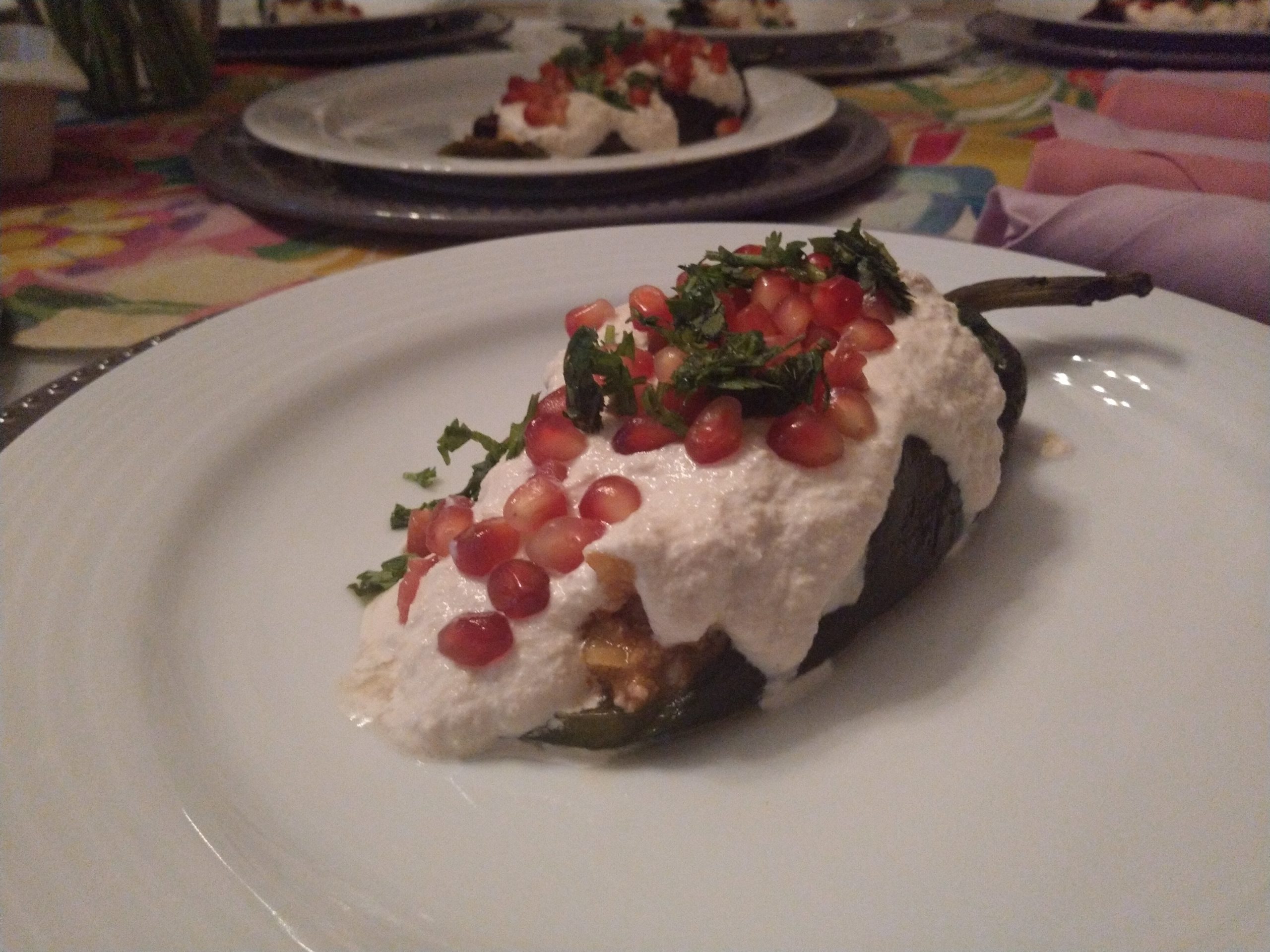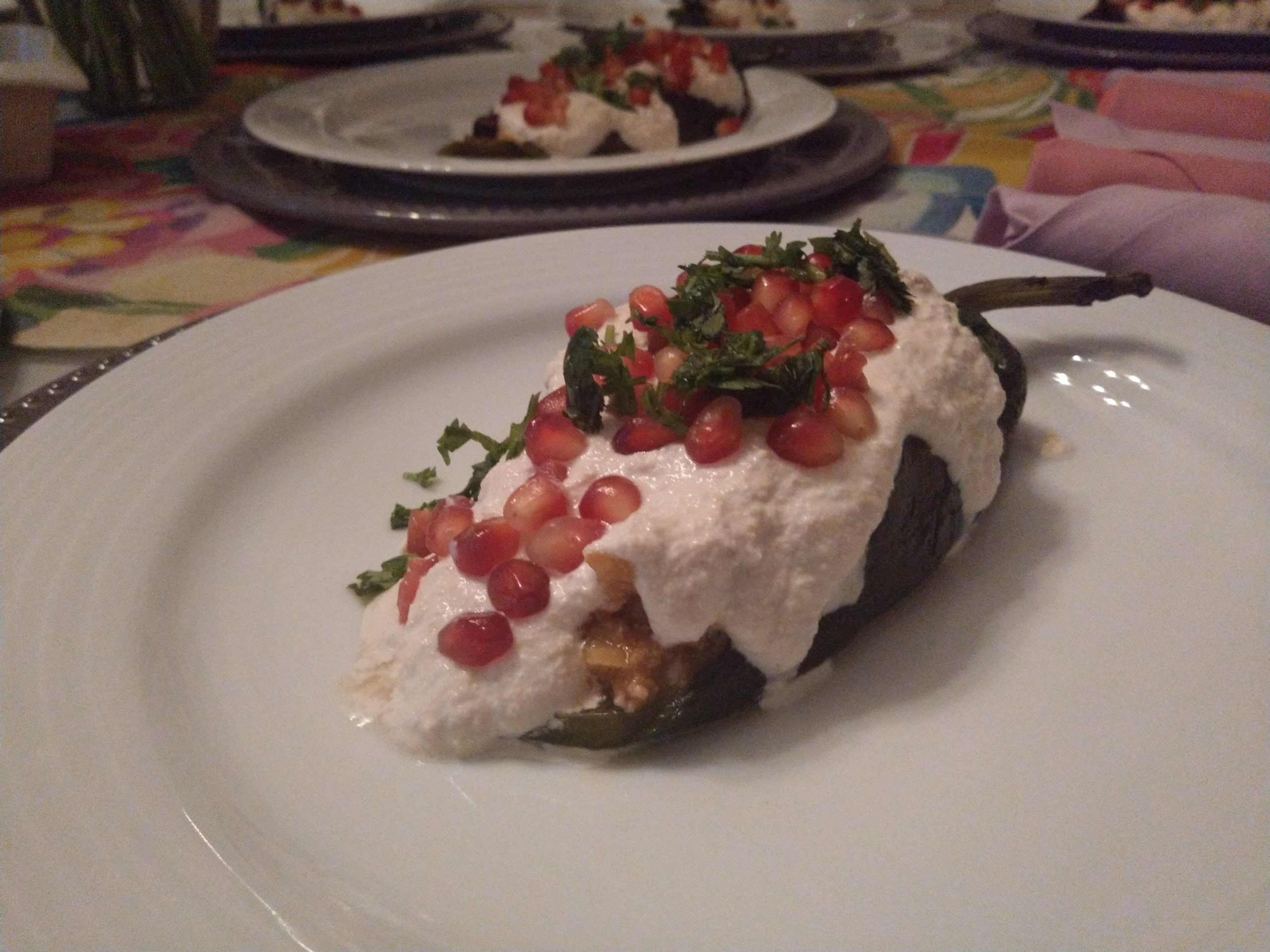To talk about Chiles en Nogada seems to me is to go looking for unnecessary trouble if we don’t really know what it is all about. And hey, I don’t mean that they are difficult to make. I mean, anyone who can prepared stuffed chiles or pepper is competent enough for making this well-known dish. It is also true, that there are many myths and stories around it. I also believe that any co-national will agree to taste this delicacy and even more to be able to share it with friends and new acquaintances who come from far away lands is an honor. However, it is not necessary to go and spend a fortune in one of these delights if we want to pamper a bit the tummies at home.
But before we start chopping, de-seeding, and and seasoning, I feel obliged to share one of the many stories around the origin of the chile en nogada. Now, this is also one of my favorite dishes. And I must underline that there are many versions to the legend behind the dish, but I shall sustain that when I first learned it, I believed it. It’s quite ironic that an Englishman who didn’t cook but who had fallen in love with them shared it after having done his own research about them while living in Mexico. Today, I know this story is a legend. Nonetheless, I share it because it’s one of the most popular ones. But I insist, IT’S A LEGEND.
The Legend of Agustín de Iturbide
In 1821, Mexico through Agustín de Iturbide, a military who fought for Mexico’s Independence, the Córdoba Treaty was signed with Juan O’Donojú in the city with the same name. This lead to Mexico’s Independence. Upon his return to the city of Puebla the Augutinian Sisters of the Convent of Saint Monica were celebrating their patron, St. Auguste on August 28th. For the celebration, we believe, the nuns had been planning for months a recipe of something innovative with the seasonal products found in the region. The recipe incorporated the colors of the Trigarante Army.
Lastly, and before getting busy in the kitchen, I want to emphasize that this does not match the coronation of Independent Mexico’s first emperor, since the latter took place until 1822.
With or Without Batter?
Every historic cookbook, starting with La Cocinera Poblana, includes batter in Chiles en Nogada. Currently, I believe people enjoy them more without. And I attribute it to the fact that cuisines everywhere are getting lighter. Let us just glance at how our diets have evolved. Aren’t we trying to reduce calories and make dishes healthier?
Having said that, at home, we eat them without any batter. But if you want them 100% traditional, go ahead and add the batter. I’ve also heard that many aren’t fond of fried foods anymore.
But that’s more than enough introduction. So, the recipe I’m sharing today is one I quite a few years ago. It was September. Lively patriotism everywhere, so I went to eat to a now-extinct restaurant in Mexico City. The chef’s special included a printout of his recipe. Like I said, the place went out of business. But, I saved the recipe in my files. Now, as Independence Day arrives, this is the one I follow whenever I enter the kitchen and prepare them.

Equipment
- Comal or griddle
- Chopping board
- Chef's Knife
- Food processor
- Big pot
- Wooden spoon
- Bowls in various sizes
- Sieve
- Blender
- Plastic bag
Ingredients
For the peppers:
- 12 Poblano peppers
- 300 ml oil
- 1 Kg ground beef, there are people who prefer 50% beef and 50% pork
- 250 ml chicken stock
- 1 onion, finely diced
- 2 garlic cloves, finely chopped
- 6 tomatoes, diced
- 4 pitted olives, chopped
- 6 capers
- 5 Bartlett pears, diced
- 4 apples, diced
- 6 plantains, diced
- 3 peaches, diced
- 100 g almonds, silvered
- 100 g raisins
- 75 g candied pineapple
- 1 clove
- cinnamon, ground
- salt, pepper, and sugar, to taste
- 1 dash dry Sherry
- 5 eggs, only if poblanos will be coated with batter
- 200 g all-purpose flour, only if poblanos will be coated with batter
For the nogada sauce:
- 300 g walnuts, peeled
- 200 g ricotta or goat's cheese
- Dry Sherry, as necessary
- Sugar to taste
Para la decoración:
- 5 pomegranates, only the seeds
- heavy cream or milk, as necessary
- Parsley leaves
To Prepare
For the chiles:
- Toast the poblano peppers on your comal or griddle. Let them sweat in a plastic bag to take off the skin. Before cleaning them, there are some people who will put on some oil in their hands, others prefer wearing latex gloves and clean the inside of the peppers -taking the seeds and veins out- without having the risk of having chilly fingers. Also, for those who do not like their poblanos very spicy, there are people who soak the peppers in salted water for a while to calm the spiciness as much as possible.
- Separately, heat a big enough pot with about 2 Tablespoons of the oil and sautée the finely chopped onion and garlic. Add the ground meat, the tomato previously roasted, peeled, and chopped, as well as the chicken stock. Let it cook at a medium heat until the meat is tender and there is no liquid left in the preparation. Add the spices, the fresh fruit chopped into small cubes, the dry raisins, candied pineapple, capers, chopped olives, and slivered almonds. Season with salt, pepper, a pinch of sugar (if needed), and a touch of sherry. Let the cooking liquid evaporate. Once the stuffing is ready, set aside and let it cool down.
For the nogada sauce:
- Even though everyone recommends preparing the nogada one hour before serving to avoid oxidation, the walnuts must be cleaned, peeled and let to rest in milk since the night before. Consider that in order to peel the walnuts more easily, soaking them in hot water will help. Thus, before serving, put in the blender or food processor the peeled walnuts with the milk they were soaked in, the cheese, a pinch of sugar, cinnamon, and half a glass of dry sherry. Adjust the seasoning with a bit of heavy cream or milk if deemed necessary. The result must be a smooth sauce.
Plating:
- Once the poblano peppers have been stuffed, they may be covered with the egg batter. To do so, beat the five egg whites to stiff peaks, and then incorporate the egg yolks. Cover the poblano peppers with flour, and then with the beaten airy eggs and fry in a skillet with hot oil. On the other hand, I prefer to have mine without the batter coating, but that is a license I allow myself to take, for the batter coating is a feature of the cuisine of the period when they were invented for a feast preparation as this one. Also, please consider that this is a plate that is served at room temperature and served with the nogada sauce on top, and decorated with the pomegranate seeds and a bit of parsley leaves coarsely chopped.

